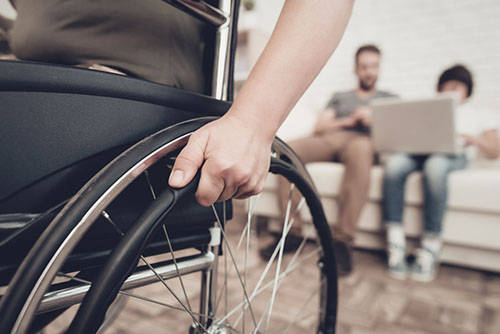Motorcycle accidents happen practically everyday in Indiana and pose an extreme safety and economic issue for riders. While helmets and anti-lock brakes make motorcycling safer, riding a motorcycle is riskier than driving an automobile. Maintaining control is more difficult on two wheels, and when collisions happen, motorcyclists are at greater risk of serious injury or death because they don’t have an enclosed vehicle or safety belts for protection.
What can a motorcyclist do to decrease the severity of injuries in the event of a collision?
- Wear a helmet. The federal government estimates that wearing a helmet reduces the risk of dying in a crash by 37 percent. Unhelmeted riders are three times more likely than helmeted ones to sustain traumatic brain injuries in the event of a crash.
- Install anti lockProtecting braking systems to prevent wheels from locking up. The rate of fatal crashes is 31 percent lower for motorcycles equipped with optional antilock brakes than for the same models without them.
- Avoid lane splitting. Lane splitting is driving between two lanes of cars, usually in heavy traffic. This is not authorized in the State of Indiana.
- Avoid speeding.
- Don’t ride while alcohol or drug-impaired.
Gear
Wearing the proper gear is vital to avoiding serious injury. Riders should protect their:
- Head: Wearing a helmet can reduce the risk of head injury by over 60%.
- Eyes: Covering the eyes with goggles or a full face helmet is ideal to avoid blurred or impaired vision.
- Hands: To avoid harsh abrasions as well as extreme temperatures, wear gloves that are made of a durable material.
- Arms and legs: Even during warm temperatures, riders’ arms and legs should be completely covered.
- Feet: Sturdy boots or shoes that cover the ankles should be worn while riding.
However well or ill-equipped, motorcyclists are not necessarily the at-fault parties in Indiana crashes. Statistically, the most dangerous situation for a motorcyclist occurs when cars are making left-hand turns. These collisions account for 42% of all crashes between motorcycles and other vehicles, explains the Accident Data Center.
Whether operating a car or a motorcycle, everyone who shares the road owes a duty of care to his or her fellow motorists. When traffic accidents involve collisions between cars and motorcycles, motorcyclists are especially at risk for life-altering injuries. The irony is that motorcycle riders are some of the most skilled operators on the road. But, unfortunately, it often happens that drivers of cars do not notice their presence.
Getting help from an Indiana Motorcycle Accident Attorney
If you’ve been hurt in a motorcycle accident where a driver of another vehicle was at fault, it’s important to have your case evaluated by an Indiana motorcycle accident attorney. There might be a long, complex process ahead to make sure you are reimbursed for your medical costs, loss of income, and pain and suffering. That process, perhaps lasting months and even years, is sure to include at least some of the following phases:
- Gathering evidence
- Interviewing witnesses
- Consulting with experts
- Studying accident statistics
- Negotiating
- Going to trial
To understand just how complex the process can be, you need to remember that, unlike some states that use a “no-fault” system, Indiana is a “fault” state. If you’ve suffered injuries due to a collision and if you can prove the other driver was at fault, you may use the at-fault driver’s insurance coverage to pay for your property damage, medical bills and other damages. In a comparative fault state such as ours, if you are suing the other driver and it is determined that you 51% or more responsibility for causing the accident, you would not be allowed to collect any damages.
Indiana Motorcycle Laws
Indiana has a list of requirements for motorcycle equipment and motorcycle operators. If you’ve been injured in a motorcycle accident, it is going to be particularly important to prove that you followed all of the rules and therefore were not in any part at fault in that accident.
As an Indiana motorcyclist, for example, you need to ensure that the handlebar height of your vehicle is no higher than your shoulders when you are seated in the driver’s seat. Drivers and passengers under the age of 18 must wear a helmet. Your compliance with these equipment rules and with the rules of the road will need to be proven in order to lay the fault on the other driver – or on outside factors in the accident.
How much time does all this take? In most cases the time limit to file an Indiana motorcycle accident lawsuit is two years after the date of the accident or injury. That may sound like plenty of time, but if you’re receiving treatments for injuries you’ve suffered, trying to get back into your work and home routine, and struggling to keep up with medical bills, the pressure can be enormous.
Motorcycle accidents are a major safety issue in Indiana. Whether you ride a custom Harley or a sport bike, the best thing you can do after you have been injured in an accident is to speak with an Indiana motorcycle accident lawyer to help you fight the insurance company for the compensation you deserve.
If you are still stuck trying to decide which avenue to pursue, you should contact a knowledgeable Indiana motorcycle injury lawyer to discuss your case. The attorneys at Rowe & Hamilton will provide you with a free consultation about your case when you first call. Remember, there are statutes of limitations, so you need to act fast.






